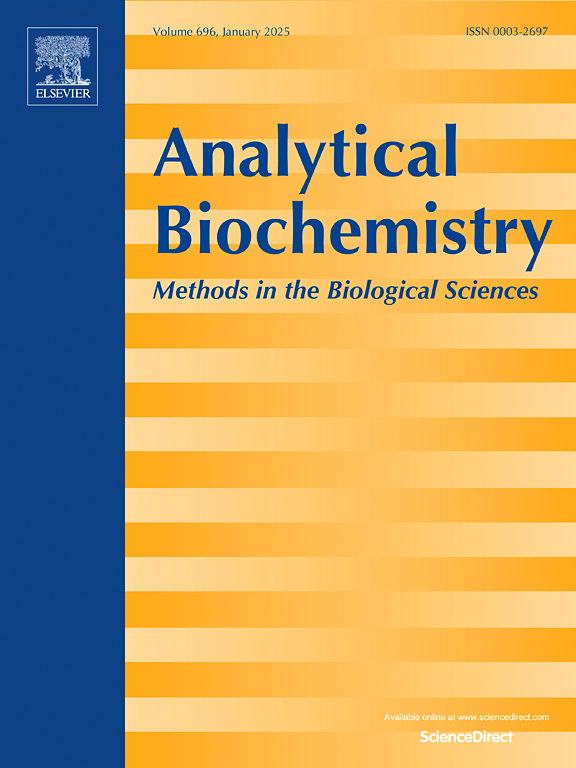来自大肠杆菌的FtsZ蛋白的流体动力学表征表明存在两种类型的三聚体。
IF 2.6
4区 生物学
Q2 BIOCHEMICAL RESEARCH METHODS
引用次数: 0
摘要
FtsZ是一种细菌蛋白,通过形成z环在细胞分裂中起着至关重要的作用。这个环作为一个支架来招募其他分裂蛋白,并指导间隔肽聚糖的合成,从而导致细胞收缩。在其天然状态下,来自大肠杆菌的FtsZ蛋白(EcFtsZ)是一种多低聚物,包括二聚体、三聚体、四聚体和六聚体,根据其浓度处于动态自结合平衡状态。本研究采用经典的分析生物化学方法,包括天然聚丙烯酰胺凝胶电泳,尺寸排除色谱,通过蔗糖梯度沉淀,以及与甲醛的化学交联来表征EcFtsZ。二聚体、三聚体和四聚体是EcFtsZ蛋白最常见的低聚物;然而,与二聚体相比,三聚体的研究还不够充分。在本研究中,我们分别用排除色谱法和沉淀法对非交联三聚体进行了表征。结果表明,EcFtsZ的非交联三聚体质量为128.8 kDa,摩擦比f/fo为1.96,与线性三聚体的理论摩擦比1.80一致。经甲醛处理后,EcFtsZ蛋白的多肽带长度为128 kDa,可被抗ftsz抗体识别,其摩擦比Smax/S20,w = 1.95,与横向三聚体摩擦比的理论计算结果一致。蛋白-蛋白相互作用预测程序(PEPPI)确定了EcFtsZ蛋白c端连接子区域亚基之间的接触位点,该位点有可能干扰ClpX(P)蛋白酶对c端连接子的识别。本文章由计算机程序翻译,如有差异,请以英文原文为准。

Hydrodynamic characterization of the FtsZ protein from Escherichia coli demonstrates the presence of linear and lateral trimers
FtsZ is a bacterial protein that plays a crucial role in cytokinesis by forming the Z-ring. This ring acts as a scaffold to recruit other division proteins and guide the synthesis of septal peptidoglycan, which leads to cell constriction. In its native state, the FtsZ protein from Escherichia coli (EcFtsZ) is a multi-oligomer comprising dimers, trimers, tetramers, and hexamers in a dynamic self-association equilibrium depending on its concentration. This study employed classical methods of analytical biochemistry that included native polyacrylamide gel electrophoresis, size-exclusion chromatography, sedimentation through sucrose gradients, and chemical cross-linking with formaldehyde to characterize the EcFtsZ. The dimers, trimers, and tetramers are the most prevalent oligomers of the EcFtsZ protein; however, the trimer has been understudied compared to the dimer. In this study, we characterized uncross-linked trimers by exclusion chromatography and crosslinked trimers by sedimentation. The results of size-exclusion chromatography demonstrated that the uncross-linked trimer of EcFtsZ has a mass of 128.8 kDa and a frictional ratio f/fo of 1.96, which coincides with the theoretical frictional ratio of 1.80 for a linear trimer. The EcFtsZ protein treated with formaldehyde resulted in a polypeptide band of 128 kDa recognized by anti-FtsZ antibodies and a frictional ratio Smax/S20,w equal to 1.95, which agrees with the theoretical calculation of the frictional ratio of a lateral trimer. The protein-protein interaction prediction program (PEPPI) identified a contact site between subunits in the C-terminal linker region of the EcFtsZ protein, which has the potential to interfere with the recognition of the C-terminal linker by the ClpX(P) protease.
求助全文
通过发布文献求助,成功后即可免费获取论文全文。
去求助
来源期刊

Analytical biochemistry
生物-分析化学
CiteScore
5.70
自引率
0.00%
发文量
283
审稿时长
44 days
期刊介绍:
The journal''s title Analytical Biochemistry: Methods in the Biological Sciences declares its broad scope: methods for the basic biological sciences that include biochemistry, molecular genetics, cell biology, proteomics, immunology, bioinformatics and wherever the frontiers of research take the field.
The emphasis is on methods from the strictly analytical to the more preparative that would include novel approaches to protein purification as well as improvements in cell and organ culture. The actual techniques are equally inclusive ranging from aptamers to zymology.
The journal has been particularly active in:
-Analytical techniques for biological molecules-
Aptamer selection and utilization-
Biosensors-
Chromatography-
Cloning, sequencing and mutagenesis-
Electrochemical methods-
Electrophoresis-
Enzyme characterization methods-
Immunological approaches-
Mass spectrometry of proteins and nucleic acids-
Metabolomics-
Nano level techniques-
Optical spectroscopy in all its forms.
The journal is reluctant to include most drug and strictly clinical studies as there are more suitable publication platforms for these types of papers.
 求助内容:
求助内容: 应助结果提醒方式:
应助结果提醒方式:


